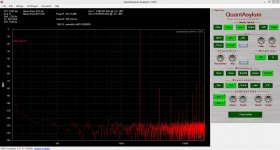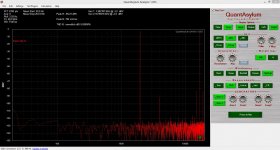One way or another, I have already made a lot of modifications at the circuit from post #9211 , now the voltage reference is feed by the output voltage insted of the input voltage (Frans suggestion), now the PSRR is even higher.
And now I have two versions one is a shunt other is a serial regulator. The serial regulator also has very good PSRR better than 130dB at audio frequencies.
And now I have two versions one is a shunt other is a serial regulator. The serial regulator also has very good PSRR better than 130dB at audio frequencies.
I also have bought some so-8 biss transistors to test, but haven't done that yet. I guess the bc857c has low parasitic capacities enough for this application. Have to buy some caps , will buy some transistors also, for this.
The important of the square wave test is to see anomalous behavior of the regulator. Some of these circuits have lots of gain and lots of BW but low slew rate, and so saturate and go nuts when you actually try to use them at the expected BW.
Last time I looked I liked the PEMZ7 from NXP.
Last time I looked I liked the PEMZ7 from NXP.
I was expecting to see some spikes at the turn on and off of the current , but as the HEC loop is faster ,maybe is because of this the reason for the absence of those abnormalities. I have to investigate futher .
I was thinking in less than 2pf collector capacitance, but thanks . NXP has nice transistors.
I will try use the bc550 just to test as I have lots of them. If the stability of the regulator stays good, I will use them.
I was thinking in less than 2pf collector capacitance, but thanks . NXP has nice transistors.
I will try use the bc550 just to test as I have lots of them. If the stability of the regulator stays good, I will use them.
No problema. To have 5v, is only need to change the value of two resistors. But first lets see if it works as planned. tomorrow will etch a pcb.
I build another buffer.
This time the Mr. Evil Diamond Fet Bootstrap.
Pictures and measurements soon.
I wanted to compare it to the Piglets Dad.
This time the Mr. Evil Diamond Fet Bootstrap.
Pictures and measurements soon.
I wanted to compare it to the Piglets Dad.
That buffer is the more interesting buffer that I have see , I don´t know if the author realized , but the fet´s and the current mirrors creates a hawksford error correction loop, I have to make something like that.
Last edited:
Yes, it is pretty clever. I have one channel working.
This beast is fast. My generator goes to 21MHz and it is still there, full steam.
Even a 20MHz sine looks pretty sine so it is even not triangulating at that frequency.
I measured distortion and i was a bit disappointed.
1V RMS into 10kOhm gave -80dB second and -110dB third.
The Piglets Dad is better in that regard. - 90dB second and no third.
The Calvin is even much better then that. I can measure no distortion at cruising level and i had to load it down really bad to see something.
I build the Mr.Evil without selecting the transistors but i thermo coupled.
This beast is fast. My generator goes to 21MHz and it is still there, full steam.
Even a 20MHz sine looks pretty sine so it is even not triangulating at that frequency.
I measured distortion and i was a bit disappointed.
1V RMS into 10kOhm gave -80dB second and -110dB third.
The Piglets Dad is better in that regard. - 90dB second and no third.
The Calvin is even much better then that. I can measure no distortion at cruising level and i had to load it down really bad to see something.
I build the Mr.Evil without selecting the transistors but i thermo coupled.
Ok . Made a mistake is not HEC, but is interesting and give me some ideas. 
If you look at the fft that is on the Mr.Evil site, you will see that 2º is at -70db of the fundamental , its not 0.00075 % for sure.
where can I find the Calvin buffer ?

If you look at the fft that is on the Mr.Evil site, you will see that 2º is at -70db of the fundamental , its not 0.00075 % for sure.
where can I find the Calvin buffer ?
He has a thread called " Simple Buffer Ideas "
Yes, the measurement on the Evil side is strange. He is talking about 1 volt but the fundamental at 1kHz is much lower.
I build now the other channel and i have trouble with noise .
I stop for today, some vinyl listening and then i go to bed.
Yes, the measurement on the Evil side is strange. He is talking about 1 volt but the fundamental at 1kHz is much lower.
I build now the other channel and i have trouble with noise .
I stop for today, some vinyl listening and then i go to bed.
Lets talk about the energy-efficiency ratio for a moment.
The Magico S1 has 82dB and drops under 4 Ohm. Lets say it is a 3.3 Ohm speaker.
The Enviee is over 8 Ohm and has 95.5dB.
So for the same output the Enviee needs 23dB less power.
That is more then 10 times better.
No matter what you do, a speaker distorts more when you crank it so the only fair comparison would be to measure the distortion at the same level, say 95dB in 1m.
OK, the Magico goes deeper in the bass.
The Magico S1 has 82dB and drops under 4 Ohm. Lets say it is a 3.3 Ohm speaker.
The Enviee is over 8 Ohm and has 95.5dB.
So for the same output the Enviee needs 23dB less power.
That is more then 10 times better.
No matter what you do, a speaker distorts more when you crank it so the only fair comparison would be to measure the distortion at the same level, say 95dB in 1m.
OK, the Magico goes deeper in the bass.
My 30W Class A tubes go so loud with the Enviee that my right ear starts to distort.
That is with 7V peak.
Also a passive crossover sucks a lot of power and stores energy.
When you think about the bumpy impedance curve you see with " conventional " high end speakers have you ever thought where that current goes ?
It cycles in the crossover.
That is with 7V peak.
Also a passive crossover sucks a lot of power and stores energy.
When you think about the bumpy impedance curve you see with " conventional " high end speakers have you ever thought where that current goes ?
It cycles in the crossover.



